Waterless fire suppression systems work by releasing gas or mixture of gasses into the air, generally with the aim of reducing the amount of oxygen in the air that feeds the flames. A clean agent fire suppression system begins with the deduction devices and ends with nozzles where the clean agent is released. From the deduction of the fire to the releasing of the agent, there are numerous devices to make the whole system run efficiently.

Components of GAS Suppression System:-
Below are some of the most common parts of a clean agent fire suppression system:
- Smoke Detectors: If a fire begins in the protected area, the smoke detector will detect the fire and send a signal to the control panel. Smoke detectors will usually sense the fire before it has had time to escalate.
 |
| Optical Smoke Detector-Apollo |
- Control Panel: The control panel is the brains of the system. When it receives a signal from the detectors, it then sends a signal to sound the notification devices and activate the release device to suppress the fire.
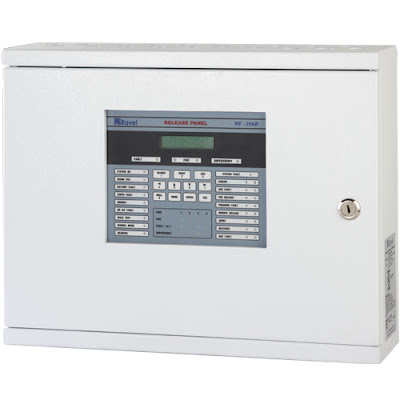 |
| Ravel RE-25 AR |
- Notification Devices: To warn those around or in the protected area that the fire suppression system is preparing to activate and release the clean agent, the control panel activates the alarm horns and strobes. The horns create a loud audible alert while the strobes create a bright visual alert.
 |
| Horn or Strobe |
- Release Device: The release device is attached to the cylinder and is activated by the control panel. The control panel activates the release device after a fire is detected, allowing the clean agent to escape from the cylinder and flood the protected area.
 |
| Release Devices |
- Cylinder/s: The cylinder is where the clean agent is stored. Depending on the size of the protected space, there can be multiple cylinders or one very large cylinder. Some clean agents are stored as a gas while others are stored as a liquid gas.
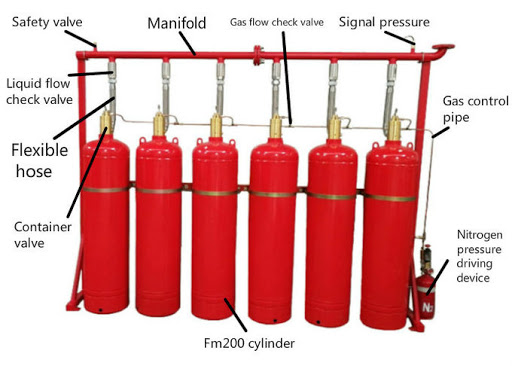 |
| The cylinder used in Gas Suppression System |
- Nozzles: Once the clean agent has been released from the cylinders, it travels down the pipes and exits out of the strategically placed nozzles. Nozzles in the middle of the protected space will be 360-degree nozzles allowing the clean agent to disperse all around the nozzle. Nozzles installed near walls will usually be 180-degree nozzles which disperses the clean agent away from the wall.
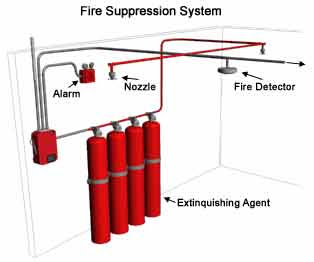 |
| NOZZLES |
 |
| NOZZLES |
- Abort Switch: The abort switch is usually a large button that is located near the clean agent system or near the door of the protected space. By depressing the button and holding it, the system is paused allowing personnel to evacuate the area before the clean agent is dispersed. Once everyone has evacuated, the button can be released and the system will continue the process of activating the clean agent system. Note that this button will not stop the system from activating. It will only delay the system from activating.
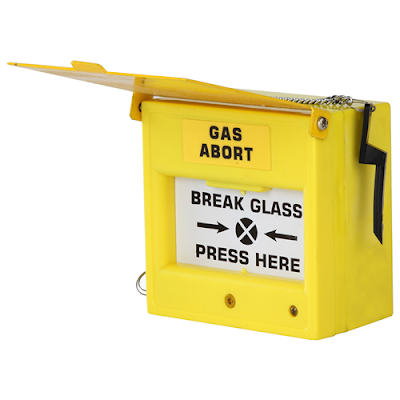 |
| Abort Switch |
- Maintenance Switch: All fire suppression systems require routine inspections and maintenance. The maintenance switch can be used during the inspections to turn off the system so it doesn’t accidentally discharge during maintenance.
 |
| Maintenance Switch |
- Manual Release: The manual release allows personnel to bypass the normal process described above and activate the system and release the clean agent manually. Once the release has been pulled, the clean agent fire suppression system will activate, sending the agent through the system and out the nozzles to suppress the fire.
- Manual call point:- MCP is the point in a structure where a switch utilized physically to initiate an alarm, this requires human intercession. Manual call focuses are utilized to start a caution signal and work by methods for a straightforward catch press or when the glass is broken uncovering a catch.
 |
| Manual Call Point |
PROINERT™ SYSTEMS:
PROINERT™ is a clean agent fire extinguishing system using an inert gas (IG55, IG541, IG100 or IG01) and is utilized in complete flooding frameworks.
PROINERT™ has gotten generally acknowledged as the best performing, most financially savvy, and naturally agreeable inert gaseous suppression system, offering broadened hold times and incredible adaptability in the plan.
PROINERT™ is a perfect decision for a wide assortment of ventures and applications, appropriate for offices, for example, PC rooms/server rooms, broadcast communications offices, and so forth. PROINERT™ is one of a kind in that it uses a weight directing release valve that produces lower release pressures which additionally converts into lower costs all around, bringing about investment funds with pipework, venting region and chamber stockpiling.
 |
| PROINERT System |
- Active Fire Listing, FM and UL Approved
- Safe for use in occupied areas
- Zero global warming potential
- Zero ozone depleting potential
- Superior design allows for convenient long pipe runs
- Minimizes downtime of vital system operations
- Leaves no residue, is non-conductive and does not require costly clean-up
- Extinguishing a fire quickly and effectively
- Utilizes 300 bar storage pressure
- Discharges in 60 seconds or less
FM-200® AS THE EXTINGUISHING AGENT:
FM-200® (HFC-227ea) Clean Agent fire extinguishing systems are the most generally utilized of all the halocarbon vaporous operators and are all around acknowledged as the best specialist used to replace Halon 1301.
FM-200® is a chemical agent specialist utilized fundamentally incomplete flooding frameworks and has been introduced in more than 200,000 frameworks around the world.
FM-200® fire suppression systems shield everything from PC rooms/server rooms, data centers, media communications offices, and shift gear to military vehicles, innovative clinical applications, and delight art to inestimable gems and memorable tourist spots the world over.
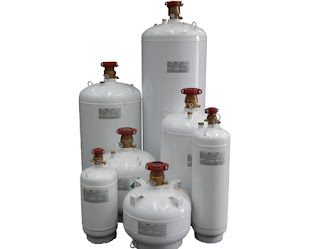 |
| FM 200 GAS System |
- Discharges in 10 seconds or less
- Extinguishing a fire quickly and effectively
- Leaves no residue, is non-conductive and requires no costly cleanup
- Reduces loss and damage due to fire and helps ensure business continuity
- Minimizes downtime of vital system operations
- Requires minimal container storage space
- Superior design performance allows for greater flexibility
- Zero ozone depleting potential
- Low global warming potential
- Short atmospheric lifetime
- Safe for use in occupied areas
- Best warranty in the fire protection industry
- Active Fire Listing, FM and UL Approved
- HFC-227ea
CO2 EXTINGUISHING AGENT:
Carbon dioxide (CO2) is a colorless, odorless, electrically non-conductive gas that is profoundly proficient. CO2 has been utilized as an extinguishing agent for over 80 years and was the principal vaporous operator utilized for fire concealment. It very well may be utilized for neighborhood application and all-out flooding frameworks and is fit to a wide scope of utilizations and dangers.
CO2 has a high pace of development empowering rapid fire suppression and gives an overwhelming cover of gas that decreases the oxygen level to a point where ignition can't happen. CO2 can't for consumed spaces except if fitted with a wellbeing interlock device to keep the framework from releasing when the fenced-in area is involved. Like all fire protection systems, CO2 systems should just be structured by experienced designers.
CO2 can be utilized to ensure applications, for example, generator sets, turbines, switchgear, combustible fluid showers, electrical walled in areas and transformers.

- Extinguishing a fire quickly and effectively
- Leaves no residue, is non-conductive and doesn’t require costly cleanup
- Minimizes downtime of vital system operations
- Superior design performance allows for greater flexibility
- Zero ozone depleting potential
- Zero global warming potential
- Active Fire Listing, FM and UL Approved
- CO2
Novec™ 1230
Novec™ 1230 Fire Protection Fluid, is a second-age clean operator fire extinguishing agent. Novec™ 1230 is a chemical agent utilized basically in all-out flooding systems and is the most environmentally benign of all the synthetic specialists. Novec™ 1230 is genuinely a genuine leap forward in clean operator innovation, a fluid at room temperature, it looks, feels and acts like water, permitting adaptability in energizing strategies. Specifically, our higher storage pressure at 34.5 bar (500psi) permits the best adaptability for the system structure.
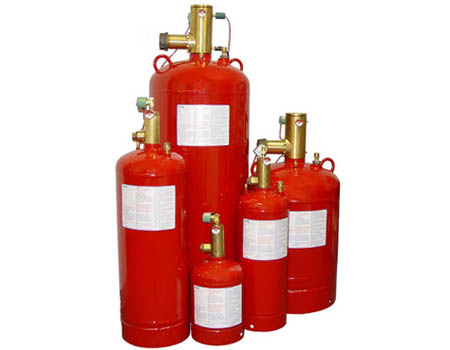 |
| NOVEC 1230 GAS System |
Hybrid Water Mist Systems:-
Hybrid Water Mist Systems are a mix of clean operator inactive gas and water. The fog is created in a way that amplifies the best qualities of each. Nitrogen is infused into the water stream at the nozzle delivering amazingly little droplets and furthermore acting to diminish the oxygen fixation in the secured hazard. This converts into a Water Mist framework that is basically dry making it perfect for the security of PC rooms, server rooms, data center and so forth.
The Water Mist droplets (under 10 micron) are up to multiple times littler than water particles conveyed by a traditional water mist system, giving half improved warmth ingestion and absolute extinguishment. Almost zero water buildup in ensured regions implies there is no water harm after the fire is stifled. Hybrid systems easily extinguish little fires in huge rooms and furthermore function admirably in normally ventilated situations.
The homogeneous mixture of water droplets and nitrogen gas is propelled with enough energy to overcome the drag effect that has limited the effectiveness of traditional Water Mist systems.
- Water/Nitrogen
 |
| Hybrid Water Mist System |
There are four means used by the agents to extinguish a fire. They act on the "fire tetrahedron":-
 |
| FIRE TETRAHEDRON |
- Reduction or isolation of fuel. No agents currently use this as the primary means of gas suppression.
- Reduction of heat. Representative agents:- Clean agent FS 49 C2 (NAF S 227, MH 227, FM 200), NOVEC 1230, pentafluoroethane (NAF S 125, ECARO-25).
- Reduction or isolation of oxygen. Representative agents:- Argonite/IG-55(ProINERT), CO2 carbon dioxide, Inert Gas 541 (IG-541 Inergen) and IG-100 (NN100).
- Inhibiting the chain reaction of the above components. Representative agents: FE-13, 1,1,1,2,3,3,3-Heptaflouropropane, FE-25, Haloalkanes, Bromotrifluoromethane, trifluoroiodomenthane, NAF P-IV, NAF S-III, NAF S 125, NAF S 227, and Triodide (Trifluoroiodomethane).
Fire Suppression System is a suitable agent for normally occupied spaces. Fire suppression systems are commonly used.
- DATA Center
- Communication Rooms
- Telecommunication Facilities
- UPS Rooms
- Medical Facilities
Tubing System
These systems use our unique patented linear detection tubing which is installed throughout the panels and cableways. This tubing can not only quickly and accurately detect a fire but also suppress it before it can damage adjacent components. These systems do not need complex electronic detectors or panels and operate simply using pneumatics.
They designed for installation inside enclosures and inaccessible areas. This alleviates the need for separate power supplies or battery backups and also makes the entire system fail safe with minimal moving parts with the best cost-performance ratio. A choice of non-conductive extinguishants is available which will not damage the electrical components or leave a residue. These include Novec 1230 from the 3M company which is both non-toxic and the most environmentally friendly agent currently available.
FIRE TUBE – THE DIFFERENCE
- Acts as multi-sensor and multi extinguishing jet.
- Made of a high-tech polymer.
- Combines long-time resistance & flexibility.
- Temperature sensitivity, when bursting at the hottest spot, it ruptures as a nozzle shape opening.
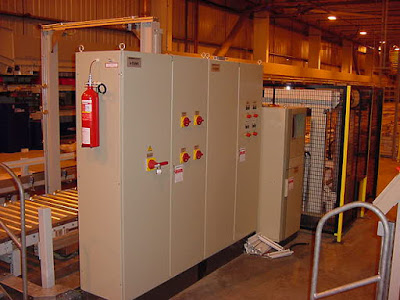 |
| Tubing System |
Types Of Tubing System:-
THE DIRECT SYSTEM
The extinguishing agent is transported through the tube exactly to the origin of the fire.
Cylinder Containing:
Water, Foam, Powder, CO2, Argonite, Clean Agent Gas, Etc.
 |
| Direct Tubing System |
THE INDIRECT SYSTEM
The detection tube just triggers the value when it detects a fire. The extinguishing agent discharges through a conventional outlet port.
Cylinder Containing:
Water, Foam, Powder, CO2, Argonite, Clean Agent Gas, Etc.
 |
| Indirect Tubing System |
 |
| COMPONENTS of Tubing System |
ADVANTAGES:-
- Linear detection line
- Rapid reaction time
- 24 hours a day ready for use
- No external power supply
- Flexible positioning of the Safex tube
- Can be installed into inaccessible areas
- Minimal environmental damages
- Minimum maintenance
- No accidental discharges through a disruption of the fire detector
- Can be used in every environment (marine, industrial atmosphere)
- Low and high-pressure applications Not affected by vibration or knocks
- Quick and simple installation
- Low price – high-performance relationship
 |
| Heat Sensing Tube Based Fire Detection |


Comments